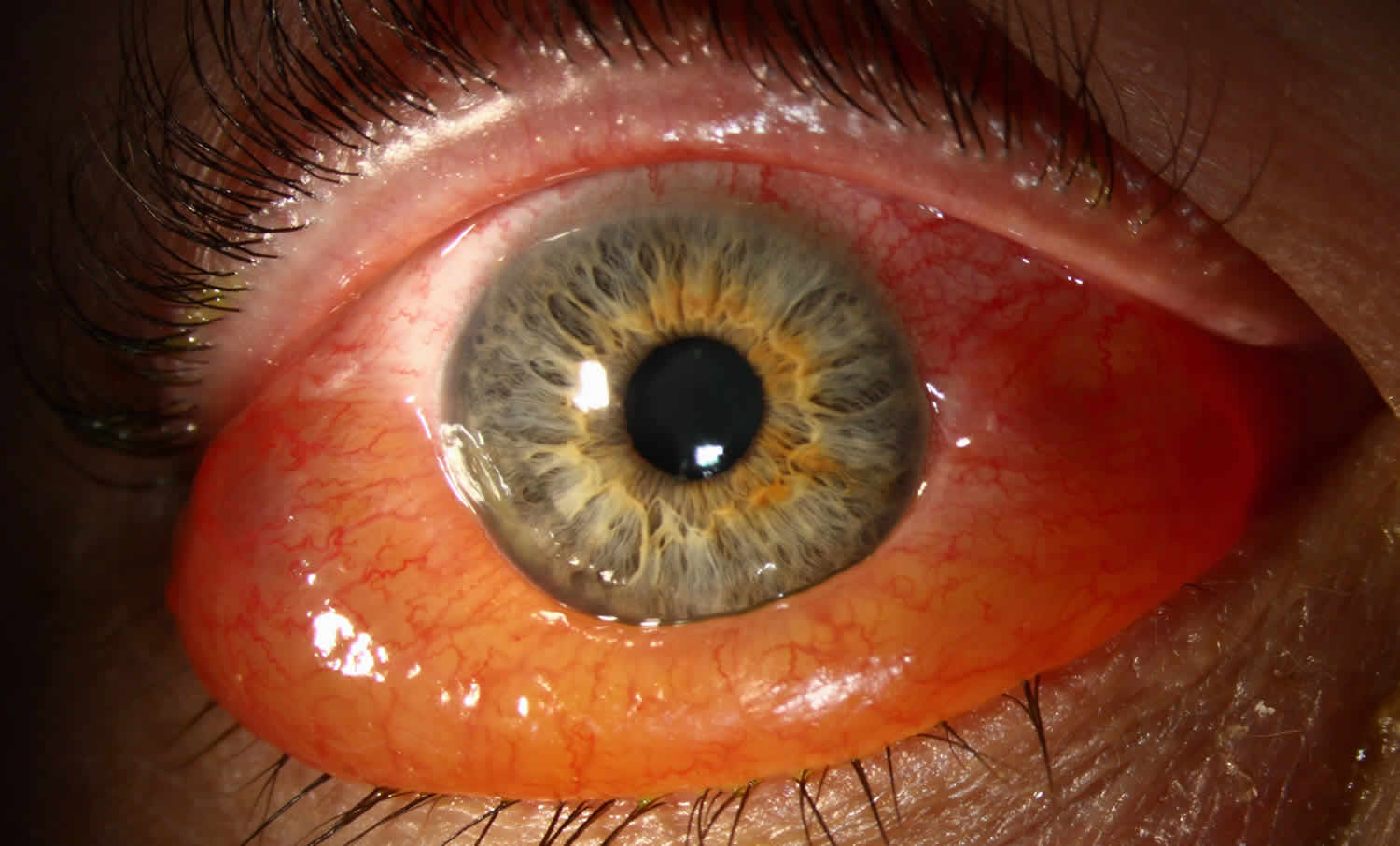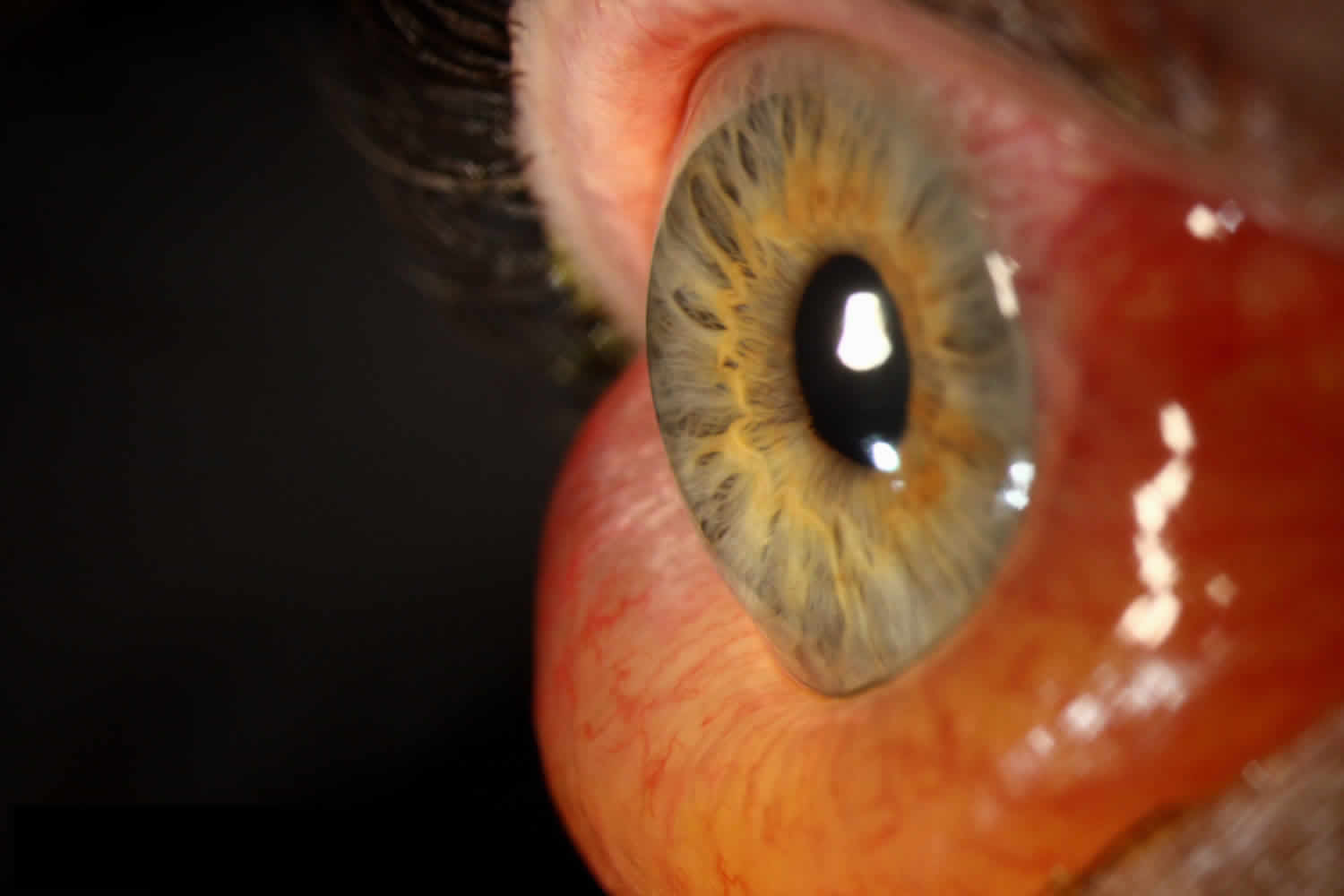What is chemosis
Chemosis is swelling of the eye surface membranes that lines the eyelids and surface of the eye (the conjunctiva), because of accumulation of fluid. Chemosis is a sign of eye irritation. The outer surface of the eye (conjunctiva) may look like a big blister. It can also look like it has fluid in it. When severe, the tissue swells so much that you can’t close your eyes properly.
Chemosis is often related to allergies or an eye infection. Chemosis can also be a complication of eye surgery, obstruction of lymphatic and venous outflow or it may occur from rubbing the eye too much or presentation of thyroid eye disease.
Chemosis is usually self-limiting or shows complete recovery following removal of the causal factor or if the underlying condition is treated. However, in some patients swelling of the conjunctiva may persist for over 6 months with no obvious cause (chronic localized conjunctival chemosis) 1. In some idiopathic cases, tissue inflammation or lymphangiectasia may give rise to irreversible chronic chemosis 2.
Figure 1. Chemosis
See your doctor if:
- Your symptoms do not go away with over-the-counter antihistamines and cool compresses placed on the eyes.
- You have other symptoms, such as eye pain, change in your vision, sensitivity to light, a severe headache and feeling sick, difficulty breathing, or fainting.
- You’ve recently injured your eye, particularly if something has pierced it
Chemosis vs Conjunctivitis
Conjunctivitis is the inflammation of the outer layer of the eye and inside of the eyelid. It can cause swelling, itching, burning, discharge, and redness. Conjunctivitis is an eye condition caused by infection or allergies. It usually gets better in a couple of weeks without treatment. Conjunctivitis is also known as red or pink eye.
Conjunctivitis usually affects both eyes and makes them:
- bloodshot
- burn or feel gritty
- produce pus that sticks to lashes
- itch
- water
Conjunctivitis (pink eye) causes include:
- Bacterial or viral infection
- Allergies
- Substances that cause irritation
- Contact lens products, eye drops, or eye ointments
Conjunctivitis (pink eye) usually does not affect vision. Infectious conjunctivitis (pink eye) can easily spread from one person to another. The infection will clear in most cases without medical care, but bacterial conjunctivitis needs treatment with antibiotic eye drops or ointment.
Chemosis causes
Causes of chemosis may include:
- Angioedema: Angioedema may be caused by an allergic reaction. During the reaction, histamine and other chemicals are released into the bloodstream. The body releases histamine when the immune system detects a foreign substance called an allergen. The following may cause angioedema:
- Animal dander (scales of shed skin)
- Exposure to water, sunlight, cold or heat
- Foods (such as berries, shellfish, fish, nuts, eggs, and milk)
- Insect bites
- Medicines (drug allergy) such as antibiotics (penicillin and sulfa drugs), nonsteroidal anti-inflammatory drugs (NSAIDs) (e.g., aspirin, ibuprofen (Advil, Motrin IB, others), naproxen [Aleve]), and blood pressure medicines (ACE inhibitors and calcium channel blockers)
- Pollen
- Environmental factors. Examples include heat, cold, sunlight, water, pressure on the skin, emotional stress and exercise.
- Underlying medical conditions. Hives and angioedema also occasionally occur in response to blood transfusions, immune system disorders such as lupus, some types of cancer such as leukemia and lymphoma, autoimmune disorders such as lupus and thyroid conditions and infections with bacteria or viruses such as hepatitis, HIV, cytomegalovirus, and Epstein-Barr virus.
- Genetics. Hereditary angioedema is a rare inherited (genetic) form of the condition. It’s related to low levels or abnormal functioning of certain blood proteins that play a role in regulating how your immune system functions.
- In most cases, the cause of angioedema is never found.
- Allergic reaction (hay fever conjunctivitis)
- Bacterial infection (bacterial conjunctivitis)
- Viral infection (viral conjunctivitis)
- Thyroid eye disease (Graves’ ophthalmopathy): an autoimmune inflammatory disease of the eye and surrounding tissues
Chemosis treatment
Over-the-counter antihistamines and cool compresses placed on the eyes may help with symptoms due to allergies. Ice water compresses should be utilized continuously for 3 days (except when eating or sleeping). Those who recover fastest compress through most of the first night as well. Ice packs or frozen masks are too heavy, which may damage the eyelid tissues. Patients should rest with their head up at least 45 to 60 degrees.
People with angioedema should:
- Avoid any known allergen or trigger that causes their symptoms.
- Avoid any medicines, herbs, or supplements that are not prescribed by a provider.
Medicines used to treat angioedema include:
- Antihistamines
- Anti-inflammatory medicines (corticosteroids)
- Epinephrine shots (people with a history of severe symptoms can carry these with them)
- Inhaler medicines that help open up the airways
If the person has trouble breathing, seek medical help right away. A severe, life-threatening airway blockage may occur if the throat swells.
References- Chronic localized conjunctival chemosis. Kalin NS, Orlin SE, Wulc AE, Heffler KF, Frayer WC, Sulewski ME, Mittra RA, Cavanagh HD. Cornea. 1996 May; 15(3):295-300. https://www.ncbi.nlm.nih.gov/pubmed/8713933/
- Kim KH, Kim WS. Chronic unilateral chemosis following the use of amlodipine besylate. BMC Ophthalmol. 2014;14:124. Published 2014 Oct 21. doi:10.1186/1471-2415-14-124 https://www.ncbi.nlm.nih.gov/pmc/articles/PMC4216336/







